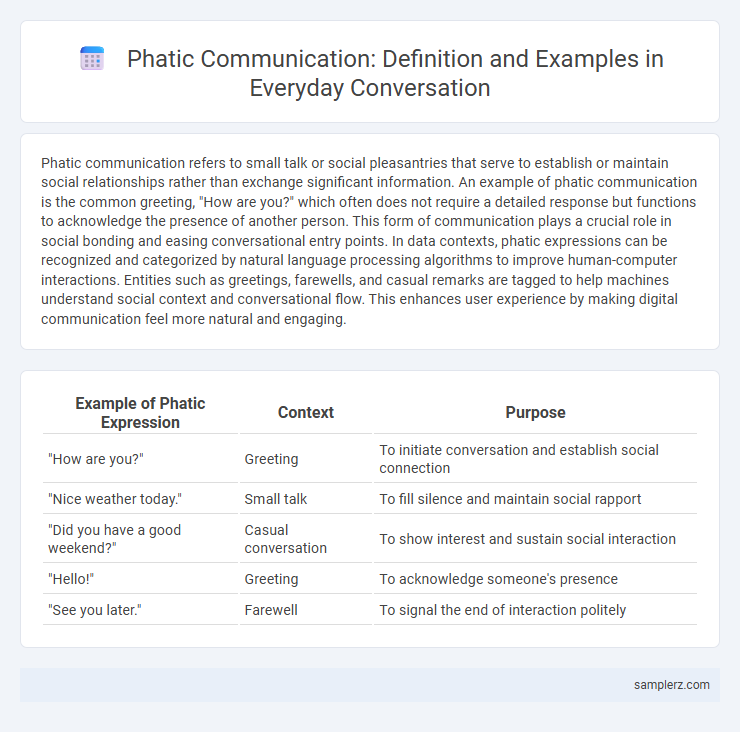Phatic communication refers to small talk or social pleasantries that serve to establish or maintain social relationships rather than exchange significant information. An example of phatic communication is the common greeting, "How are you?" which often does not require a detailed response but functions to acknowledge the presence of another person. This form of communication plays a crucial role in social bonding and easing conversational entry points. In data contexts, phatic expressions can be recognized and categorized by natural language processing algorithms to improve human-computer interactions. Entities such as greetings, farewells, and casual remarks are tagged to help machines understand social context and conversational flow. This enhances user experience by making digital communication feel more natural and engaging.
Table of Comparison
| Example of Phatic Expression | Context | Purpose |
|---|---|---|
| "How are you?" | Greeting | To initiate conversation and establish social connection |
| "Nice weather today." | Small talk | To fill silence and maintain social rapport |
| "Did you have a good weekend?" | Casual conversation | To show interest and sustain social interaction |
| "Hello!" | Greeting | To acknowledge someone's presence |
| "See you later." | Farewell | To signal the end of interaction politely |
Understanding Phatic Communication: Definition and Importance
Phatic communication involves simple, routine exchanges such as greetings like "How are you?" or small talk about the weather, which help establish social connection and ease interaction. These expressions do not convey significant information but play a crucial role in building rapport and maintaining social bonds. Understanding phatic communication highlights its importance in creating a comfortable communication environment and fostering interpersonal relationships.
Everyday Examples of Phatic Expressions
Phatic expressions such as "How are you?", "Nice weather today," and "Did you have a good weekend?" serve to establish social connection rather than exchange information in everyday communication. These phrases act as conversational lubricants that foster interaction and rapport between individuals. Common in both casual and professional contexts, phatic communication helps maintain social bonds by promoting a sense of friendliness and approachability.
Phatic Communication in Workplace Interactions
Phatic communication in workplace interactions includes greetings like "Good morning" and casual questions such as "How was your weekend?" that establish social rapport and create a friendly atmosphere without exchanging substantial information. These exchanges help build trust and ease collaboration among colleagues by maintaining open channels for dialogue. Effective use of phatic communication reinforces team cohesion and promotes a positive organizational culture.
Digital Age: Phatic Communication in Online Messages
Phatic communication in the digital age often appears through brief greetings like "Hey, how are you?" or emojis in online messages, serving to establish social connection rather than exchange information. Platforms such as social media and instant messaging apps rely heavily on these phatic expressions to maintain relationships and create a sense of presence. This type of communication plays a critical role in fostering engagement and social bonding in virtual environments.
The Role of Small Talk in Building Relationships
Small talk serves as a crucial phatic function in communication by facilitating social bonding and easing interpersonal interactions. Common examples include greetings like "How are you?" or comments about the weather, which create a comfortable environment for deeper conversations. These brief exchanges help establish rapport, signaling openness and trust essential for building relationships.
Cultural Variations in Phatic Communication
Phatic communication varies significantly across cultures, exemplified by greetings such as the Japanese "Ohayo gozaimasu," which conveys politeness and respect, contrasting with the casual "Hey" often used in American English. In many Middle Eastern cultures, extended inquiries about health and family serve as phatic expressions, reinforcing social bonds rather than exchanging information. Understanding these cultural variations is essential for effective intercultural communication and avoiding misunderstandings.
Phatic Expressions During First Impressions
Phatic expressions such as "Hello," "How are you?" and "Nice to meet you" play a crucial role in building rapport during first impressions by establishing social connection and easing conversational flow. These brief, formulaic phrases do not convey significant information but signal friendliness and openness, helping to reduce social distance. Effective use of phatic expressions creates a positive atmosphere that fosters trust and encourages further communication.
The Psychological Impact of Phatic Communication
Phatic communication, such as simple greetings like "How are you?" or small talk about the weather, plays a crucial role in establishing social bonds and reducing feelings of isolation. These seemingly trivial exchanges trigger psychological responses that foster trust and emotional connection, enhancing overall interpersonal relationships. Regular use of phatic communication can positively impact mental well-being by promoting a sense of belonging and social support.
Challenges and Misunderstandings in Phatic Exchanges
Phatic communication, such as greetings like "How are you?" or small talk about the weather, often aims to establish social rapport rather than convey information. Challenges arise when these exchanges are misinterpreted, leading to misunderstandings about intentions or emotions, especially in cross-cultural contexts where norms differ. The lack of substantive content in phatic communication can cause confusion, making it difficult for interlocutors to gauge sincerity or respond appropriately.
Enhancing Connection Through Phatic Communication
Phatic communication includes simple greetings and small talk, such as "How are you?" or "Nice weather today," which serve to establish and maintain social bonds. These exchanges prioritize emotional connection over information transfer, reinforcing trust and rapport among individuals. Consistent use of phatic expressions enhances interpersonal relationships by fostering a sense of belonging and mutual attentiveness.

example of phatic in communication Infographic
 samplerz.com
samplerz.com